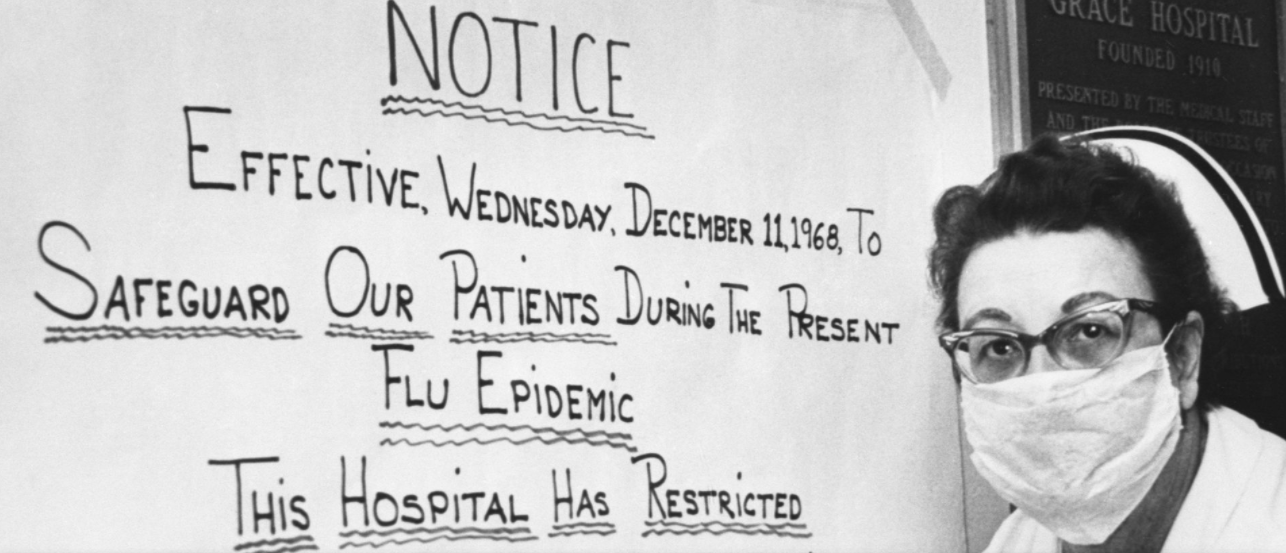Woodstock was held during a pandemic

- May 13, 2020
- admin
- Uncategorized
The year was 1968. We were locked in bitter struggle in Vietnam. In January, we got completely surprised by North Vietnam’s Tet Offensive. That was arguably the low point of the entire war. By April, we had over 540,000 troops there. 16,899 troops were killed by year-end.
Against that backdrop, Martin Luther King was assassinated. What followed were race riots in communities across the country. Then Robert Kennedy was assassinated. What followed that was the Democratic Convention in Milwaukee erupted in brutality.
When we think of 1968 today, that’s what we think of: war, politics, assassinations, riots (and dirty hippies).
But did you know that all of this went down in the middle of a deadly flu pandemic?
In 1968, the H3N2 pandemic killed more people in the U.S. than number of Americans killed in the Vietnam and Korean wars – combined. From Hong Kong, the virus killed 100,000 people that year, against our 1968 population of 205 million. That would be about 175,000 people by today’s standards. It killed more than 1 million people worldwide.
Yet every time I’ve watched a documentary or talked to someone who lived through it on that historic year, I don’t recall the pandemic being mentioned. Even during Woodstock, which happened while the pandemic continued through 1969, it hasn’t been mentioned. Not once.
“Stock markets didn’t crash because of the flu,” says Jeffrey Tucker of the American Institute for Economic Research. “Congress passed no legislation. The Federal Reserve did nothing. Not a single governor acted to enforce social distancing, curve flattening (even though hundreds of thousands of people were hospitalized), or banning of crowds. No mothers were arrested for taking their kids to other homes. No surfers were arrested. No daycares were shut even though there were more infant deaths with this virus than the one we are experiencing now. There were no suicides, no unemployment, no drug overdoses attributable to flu.”
And what about the media?
Bojan Pancevski in the Wall Street Journal points out, “In 1968-70, news outlets devoted cursory attention to the virus while training their lenses on other events such as the moon landing and the Vietnam War, and the cultural upheaval of the civil-rights movements, student protests and the sexual revolution.”
What changed? Why are things so different these days? It’s a good question.
Some folks believe it’s because we live in an age of mass media. Every moment of every day we’re getting bombarded by notifications.
That has to have something to do with it. To what extent, we may never know. But life obviously moved at a slow pace when news came out once a day.
Others believe it’s because we’ve gotten too soft as a country. We’ve become used to government solutions for every problem and won’t feel safe until government “solves” this one.
Again, that has to have something to do with is. Martin Luther King was right when he said that America has “socialism for the rich and rugged individualism for the poor.” As a rich country, we’re used to being taken care of by government.
Still others believe this is all a plot against President Trump (believe it or not) …. or that its a plot by Bill Gates and the world’s rich to gain control of the world (as if they didn’t have control it already).
(This, I am convinced, has nothing to do with it. But for those who do believe this, there’s a Zoom meeting for members of the Flat Earth Society today at 4pm).
The the world today is far different than it was in 1968. But in my view, the biggest difference is the virus itself.
Both disproportionately killed the elderly. And both viruses attacked populations with no prior immunity. But the coronavirus is much more contagious.
According to the National Institute of Health, the basic reproduction number of the 1968 flu was between 1.06 – 2.06. That means that every person who got infected passed it on to as many as 2.06 additional people. With the coronavirus, it’s estimated to be 2.2 and 2.7, according to the CDC.
The difference between 2.06 and 2.7 may not sound like a lot. But it makes the coronavirus much more contagious than the 1968 flu. And that makes it more deadly, since the more contagious it is the more likely it is to flood our healthcare system.
This isn’t a Hollywood movie. We face two bad choices right now: death by virus or death by inability to earn money, pay for health insurance and feed your family.
As Fed Chairman Powell said this morning, 40% of people who make less than $40,000 a year have already lost their jobs. And the longer we wait, the less likely it is that those jobs will ever come back.
And let’s face it: even if we stayed in lockdown for another two months, the virus would reappear as soon as we opened back up. South Korea and China and Hong Kong are proving that right now. What wouldn’t reappear when we opened back up is an economy.
Yes, there are risks we’ll have to face. But like our forefathers before us, it’s time to get back to work.
“The Buck Stops Here,”
Dylan Jovine
Chairman,
